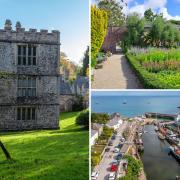Winston Graham wrote more than a dozen books in the Poldark saga as well as Marnie, made into a film by Alfred Hitchcock
As the long-awaited BBC adaptation of Poldark comes to an end PETER NALDRETT looks at the life of its inspiring author Winston Graham and the phenomenon caused by the fictional saga that continues to capture the nation’s imagination
To say he sold millions of books, the name Winston Graham is not widely known compared to some authors of classic novels. He chose to remain out of the limelight and keep a low profile, but Graham was a prolific author publishing Poldark and other novels until the year before his death - not to mention giving Cornish tourism a massive and long-lasting boost.
Born in Manchester, Winston Graham moved to Cornwall when he was 17 in a family relocation that would change his life. His new home was in Perranporth, a place he grew to love and used as one of the central settings for his Poldark novels. After nine years in Perranporth, supported by his mother who wanted to help him be a writer, Graham finally saw the publication of his first book, The House With The Stained Glass Windows. It wasn’t a hit, earning him just £29. But he persevered and during World War Two a spy thriller was released called Night Journey which captured the contemporary feeling of a Nazi controlled Europe and Britain in the middle of a crisis.
It was at the end of the war, that Winston Graham’s most renowned work was published, Novel of Cornwall was set in and around Perranporth during the 18th Century. Ross Poldark appeared in 1945 and the premise of what is now an epic tale of Cornish families was laid down in the first two chapters. Ross Poldark, a British Army officer returning injured from the American War of Independence, heads for Truro in a horse-drawn coach to find his father has died, the estate in disrepair and his long-time love, Elizabeth, engaged to marry his cousin. There’s a fair bit of turmoil for him, then. And when you throw in the chance meeting with attractive and intriguing commoner Demelza, the scene is set for action, love and wild landscapes.
Graham followed Ross Poldark with a second novel, Demelza, in in 1946 and then the Cornish saga developed through the years with Jeremy Poldark (1950), Warleggen (1953), The Black Moon (1973), The Four Swans (1976) and The Angry Tide (1977). It was these seven Poldark novels that formed the basis of the now legendary BBC Poldark series which aired in 1975 and ran for two series of 29 one-hour episodes. It’s difficult to overstate the impact Poldark had on the nation when it started showing on Sunday evenings in the mid-70s. Hot on the heels of great Sunday night dramas like The Forsyte Saga and The Onedin Line, the country was crying out for more British period drama and Poldark delivered with gusto. In the days before digital TV, DVDs and hundreds of channels, a staggering 15 million people watched the show every week. It was so popular on Sunday evenings that vicars changed church services to fit around it so the congregation could worship as well as see Ross and Demelza’s romance blossom.
Today’s adaptation, which hit our screens this year, 40 years after the first legendary adaptation, looks set to enjoy similar success - its first episode netted around seven million viewers on the night - and millions more through downloads.
While the original BBC series may have seemed like a glorious moment for Winston Graham, this was not initially the case. When Graham saw the first four scripts for the show he was not happy at some of the character changes given to Ross and Demelza and some think he would have cancelled the show if he was able to do so at that late stage. Many things, however, have to change in adapting classic novels for TV, not least giving the end of the every show a cliffhanger to finish on. Eventually Graham came to appreciate the series and visited the set and cast several times.
When the second series came to an end, cast and crew wanted to produce more shows but at that point there were no more books - and Graham refused to allow BBC scriptwriters to come up with their own tales. But for his avid readers there was more to come. Winston Graham created new generations of the legendary Cornish family. The Stranger From The Sea (1981) took the saga into the 19th Century, followed by The Miller’s Dance (1982), The Loving Cup (1984), The Twisted Sword (1990) and Bella Poldark in 2002, the year before his death. The first series of the 2015 adaptation focuses on his first two books - leaving plenty more stories for future shows.
But it is the 1970s - and now the 2015 version - TV series that most people recognise when they think of Poldark. In both there are wonderful landscape shots that provided a stunning backdrop to Winston Graham’s storylines – all providing a boost to the region’s tourism. Whether Church Cove, Gunwalloe on The Lizard, Charlestown, which stood in for the city of Truro, Porthgwarra or Levant Mine which became Ross Poldark’s fictional Wheal Leisure.
Clearly, Graham’s literary talent wasn’t limited to the Poldark series. He penned dozens of other books during his prolific career, the most successful of which was Marnie in 1964. The story centres on the life of a troubled young woman who steals and changes her identity while trying to escape the employers she has duped. Marnie was made into a film which was directed by Alfred Hitchcock and starred Tippi Hedren and Sean Connery. Five of Graham’s other novels were filmed, including Take My Life and The Walking Stick, while Marnie was also adapted for the stage in 2001.
But it was undoubtedly the Poldark series for which Winston Graham will be remembered. Seventy years since the first publication of Ross Poldark, the vivid description of the rough, harsh Cornish landscape and the intriguing contrast of rich and poor in the 18th Century continue to entertain, inform and inspire.
Scottish-based author C A Hope spent years researching her own historical novel based on social reformers at a New Lanarkshire textiles mill and cites Winston Graham’s Cornish novels as her main inspiration. I have the entire Poldark series in pride of place on my bookshelf, beside The Walking Stick and Marnie,’ she tells me. They’re there so I can easily dip into them and wallow in the era. No one catches the everyday lifestyle of that time as well as Graham, in my opinion. He makes you feel you’re there and that he’s actually been there and is just recounting it to you. All the simple, everyday aspects of life in those times are referred to or described so unpretentiously.’
Hope especially likes the way Graham used dialect to reflect the class of the character. Many sections of his Poldark novels feature conversations with few clear directives to announce who is saying what. But readers can figure it out because the characters literally have a different way of speaking, which is logical because people working in a mine wouldn’t have spoken in the Queen’s English. Graham had a talent for doing this, meaning that you could identify the difference between Prudy or Judd without the need to be constantly told who is doing the talking.
The beauty of Poldark today is that it’s still possible to visit the landscapes that inspired Winston Graham and continue to be used to such good effect by the BBC.
And with this latest adaptation - and the books still selling well - there is no sign that the saga’s popularity will wane any time soon.
This feature first appeared in the April issue of Cornwall Life



























